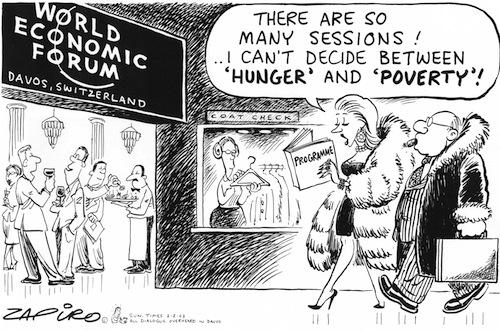
From LiveScience:
The Rich See What They Believe
By Jeanna Bryner
LiveScience Staff Writer
posted: 28 February 2007
People see what they believe, not vice versa, when it comes to social injustice.
And this mind-altering trick of perception keeps moral outrage at bay, especially among the rich, a new psychological study suggests.
By reducing outrage, this mental hoodwink also impedes social change because it inhibits people from taking action, allowing injustices to persist, said lead researcher Cheryl Wakslak of New York University.
Research has shown that people become emotionally distressed when confronted with inequality.
The privileged minority is particularly affected, and they are likely to have a nagging worry that their cash and prizes are undeserved.
To keep a clean conscience and legitimize privilege, individuals often alter their perceptions of the status quo.
The details of how that mental distortion provides the relief, however, remained a mystery until now.
Mind benders
To get at those details, Wakslak and her colleagues presented survey questions and scenarios involving just and unjust situations to about 100 undergraduate students.
Inequality in Australia: here.
MEDIA RELEASE
IBON Foundation, Inc., IBON Center 114 Timog Ave., Quezon City, Philippines
Tel. (632) 927-7060 * Fax (632) 929-2496 * E-mail: media@ibon.org * http://www.ibon.org
April 12, 2007
INCOME GAP WIDENS:
RP’S WEALTHIEST GREW RICHER UNDER ARROYO TERM
The gap between the unimaginable wealth of the country’s richest families and the poorest households highlights the yawning income inequalities that further widened under the Arroyo administration, according to independent think-tank IBON Foundation.
The richest 20% of the population account for 53% of the income pie while the bottom 20% get only 4.63.
The poorest 30% of the country’s families, some 4.9 million, had a combined income of P177 billion, according to the 2003 Family Income and Expenditure Survey (FIES). This was half of the total net worth of the Philippines’ richest: Jaime Zobel and his family, Lucio Tan and Henry Sy. According to Forbes magazine, as of Feb. 2007 the three had a total net worth of $7.5 billion or P360 billion (at P48:$1).
From 1985, the share of the poorest 60% of the population of the population fell by 1.8 percentage points while the richest 20% were able to increase their share by another 1.2 percentage points.
“This is a vivid example of the skewed income distribution prevailing in the country, which has worsened since 1985,” said IBON executive editor Rosario Bella Guzman. She added that the income of the richest 10% of the country’s households is 21 times that of the poorest 10 percent.
Guzman said the reason for such inequality was the not the failure of so-called economic growth to ‘trickle down’ to the poor, but the monopoly of ownership of the country’s productive assets, such as land and capital, in the hands of a relative few families. This denies the poor the ability to improve their lot even as the rich continue to get richer.
This is illustrated by looking at the country’s poorest sectors– marginal peasants, small fisherfolk, the urban poor– who all suffer from extreme marginalization and exclusion from economic resources and the common goods.
Unless there is more equitable access to economic assets, the poverty situation in the country will not improve, and indeed, can only get worse, Guzman said. (end)
IBON Foundation, Inc. is an independent development institution established in 1978 that provides research, education, publications, information work and advocacy support on socioeconomic issues.
LikeLike